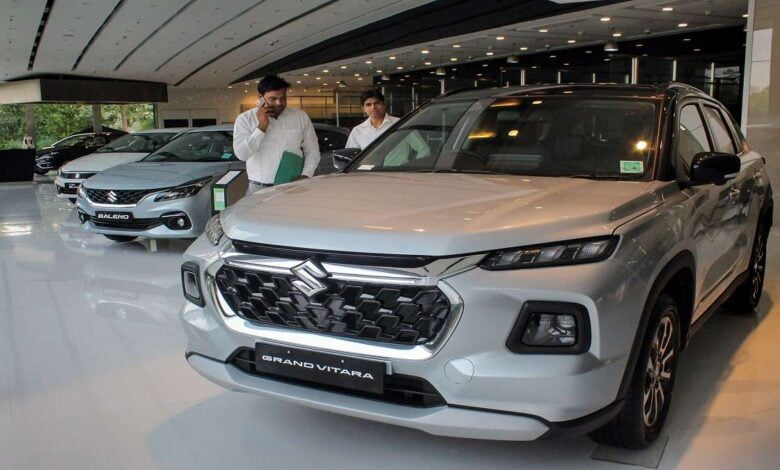The Manesar plant capacity may be increased by one lakh units by April 2024, according to Maruti Suzuki

The Manesar plant capacity may be increased by one lakh units by April 2024, according to Maruti Suzuki
India’s largest automaker may increase production capacity at its Gurugram manufacturing plant in order to meet growing demand.
MSI may raise its Manesar plant capacity by one lakh units in order to meet the increased demand before its Sonipat factory opens in 2025.
According to reports, the country’s largest automaker may consider increasing the capacity of its Gurugram plant to meet the rising demand for its products.
The combined annual manufacturing capacity of MSI’s Manesar and Gurugram factories is 15 lakh units. Additionally, the Gujarat-based factory of parent company Suzuki Motor gives them access to 7.5 lakh units.
At the new building in Kharkhoda, Haryana, the company has already started working. A 2.5 lakh unit installed production capacity in the first phase of the plant’s construction is anticipated to be operational by 2025.
We now have a capacity in Haryana and Gujarat of roughly 22.5 lakh people…
And in the future, we will be working on the Kharkhoda plant, which is currently under construction and scheduled to be operational in 2025. “To meet intermediate demand, we may need to add about 1 lakh capacity to Manesar on a short-term basis, Rahul Bharti, MSI’s Executive Director of Corporate Planning and Government Affairs, said.
Kharkhoda’s capacity may increase by one lakh units per year by April 2024, and Manesar’s by April 2025.
Several MSI products are currently available at both Gurugram and Manesar plants, including the Ertiga, XL6, and Eeco.
The company’s oldest plant, Gurugram, is MSI’s oldest, and Bharti asked if MSI was considering increasing capacity at Manesar to reduce the footprint at Gurugram: “We are not planning any reduction in Gurugram we may have to increase production in Gurugram in the short term.”
He made the following comment on the upcoming facility at Sonipat’s Kharkhoda: “By the first quarter of the year 2025, our first plant (first phase) ought to be operational. And if the demand boom in India continues, I believe we already need to start considering a second factory.”
The company would have to invest Rs 11,000 crore in the first phase of the Sonipat project. MSI will invest over Rs 7,000 crore on a number of initiatives this year, including the construction of a new factory in Haryana and the launch of new models.

As a result of the Grand Vitara and Brezza’s performance, the company had 4.12 lakh pending orders at the end of September. The corporation would be able to clear its backlog of orders with an increase in output. It works to expand its position in the rapidly expanding SUV segment despite having a significant market share in hatchbacks, sedans, and multipurpose vehicles.
According to a media report quoting an unnamed senior official from the state of Gujarat, Maruti Suzuki India plans to double its estimated manufacturing capacity at its Gujarat factory, which is planned to start operations in 2015–16. According to this source, the initial phase’s capacity would be about 5 lakh automobiles per year, which is a double-digit increase over the original estimate.
However, early reports on Maruti’s Gujarat factory indicated that it will initially have a capacity of close to 10 lakh vehicles, which is twice as many as what was recently revealed. Though the numbers (production capacity) seem erratic and ambiguous, the notion that Maruti may be thinking of tripling its Gujarat capacity may be true. MSIL hasn’t yet issued an official statement on the subject and hasn’t confirmed or denied this information.

Given the recent events at the Maruti Suzuki Manesar factory, which resulted in the death of a manager, it is very plausible that Maruti Suzuki is looking to expand its operations outside of Haryana.
Maruti Suzuki appears to have put all of its eggs in one basket so far by centralizing all of its key businesses in Haryana. The entire operation of Maruti Suzuki might be put in jeopardy in the event of a problem or a natural disaster, but by increasing capacity in Gujarat, Maruti will be able to serve a wider audience, be closer to export ports, and cut the cost of shipping automobiles to southern India.
Maruti Suzuki appears to have put all of its eggs in one basket so far by centralizing all of its key businesses in Haryana. The entire operation of Maruti Suzuki might be put in jeopardy in the event of a problem or a natural disaster, but by increasing capacity in Gujarat, Maruti will be able to serve a wider audience, be closer to export ports, and cut the cost of shipping automobiles to southern India.

Maruti Suzuki would spend up to Rs. 12000 crores developing its facilities and establishing local supply chains and vendors for the parts of its cars. In the upcoming phases, Maruti Suzuki will gradually raise production capacity. The Gujarat facility is located in Mehsana, which is around 100 kilometers from Ahmedabad. Maruti Suzuki has made it clear that, notwithstanding the recent occurrences, it would continue to operate from its Manesar factory and will not leave Haryana. The Gujarat plant will support Maruti Suzuki’s operations rather than taking the place of those in Haryana. Keep checking back to Car Blog India for the most recent information as it becomes available.
edited and proofread by nikita sharma



